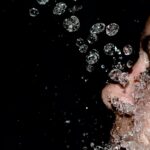My bathroom cabinet is a mess. I’ve dedicated the entire space to haircare items—brushes, combs, heat protectants, serums, oils, and styling products. Still, my hair is a lot like that cabinet—a mess. Dry, brittle, untamable, and greasy all at once. What gives?
After a chat with hair specialist Helena Rodero and a thorough read of her book All About Your Hair and Skin, I’ve been able to pinpoint exactly what’s causing my hair problems—and also, how to fix them. Turns out layering on all the hair products in the world can’t fix a head that’s suffering due to bad habits. Read on to find out what I learned and the top five signs your hair might need a little help, too.
Sign 1: Flakey scalp
Rodero says “a flakey scalp” is one of the most common issues her clients complain about. It’s also one of the most misunderstood: Most people think the flaking is caused by dry scalp, so they wash their hair less frequently. But this doesn’t get to the root of the problem. “Dandruff is caused by a fungus called Malassezia furfur, which lives on our scalp,” explains Rodero. “The problem appears when the fungus increases, causing an imbalance in the microbiota and giving rise to dandruff or seborrheic dermatitis.”
Washing our hair less actually only makes it worse, because it allows the fungus to grow out of control, thus increasing flaking. “We should wash daily or every other day—this will significantly reduce the problem,” she advises, and recommends shampoos that treat seborrheic dermatitis. These products contain ingredients that regulate sebaceous secretion up to a certain point (controlling it completely is very complicated) as well as keratolytic ingredients that help cleanse the scalp.
“The most commonly used active ingredients to treat dandruff and seborrheic dermatitis are piroctone olamine, ciclopirox olamine, selenium sulfide, and salicylic acid; They can appear alone or in combination,” Rodero explains, noting that according to clinical trials, the most effective ingredient is piroctone olamine. Look for it first in your anti-dandruff products.
Sign 2: Greasy scalp
You’ve probably heard that the best thing to do for oily hair is to wash it sparingly to regulate the oil, right? Wrong! Oily hair, as Rodero explains, is largely dependent on our hormones—which is precisely why it can be so complicated to control. Additionally, washing hair less can compound the problem: “It can cause seborrheic dermatitis to appear, which is a type of dandruff that is more oily,” Robero explains. “Then, it remains embedded in the scalp in the form of small yellow plaques.” This is why she recommends washing hair frequently instead, alternating between a shampoo for oily scalp and one that is more gentle.
Read the full article here




